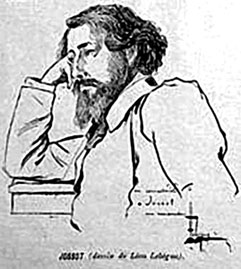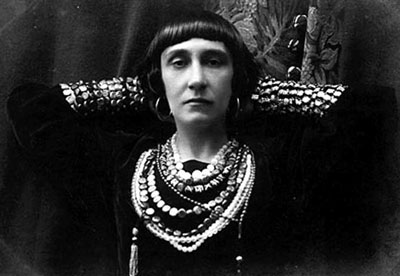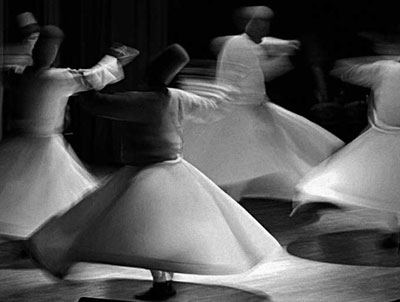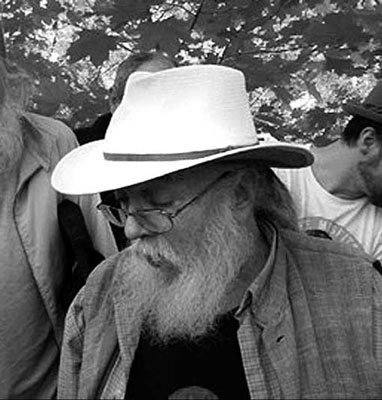religions
Islam and anarchy. A paradox to know
byFederico Battistutta
Henri Gustave Jossot, Leda Rafanelli, Hakim Bey. Three figures so different from each other, united by the coexistence of Muslim and anarchist ideals..
|
Putting together anarchy and Islam seems an impossible exercise. Nothing seems far more conceivable (Islam in Arabic means "submission"). Yet it is not, in the history of anarchism, there were people who at different times tried to talk to let these two perspectives and did succeed. Of course it is limited experience, but precisely because of their uniqueness may become examples of possible new openings for our globalized world, cultures and religions. Maybe you can look out of new scenarios in cultural miscegenation near future, because - it is better not forget it - culture is not homogeneous and unalterable block, but a living organism that historically interacts with its environment and other culture(1). Again: to talk about these experiences is a healthy antidote to the botched knowledge of the reality of Islam which, unfortunately, we learn from the versions we have on duty or fundamentalist or intolerant of our house.
As an introduction to the knowledge of this world in which authors we present three different authors that have tried to decline the original Islam and anarchism. An Islam that we will know more in the Sufi version, namely through his mystical movement, often persecuted by the Muslim theological-juridical environment for its claim to a research conducted by himself, freed from strings and snares of dogmatic beliefs.
 Henri-Gustave Jossot Henri-Gustave Jossot
 |
Henri-Gustave Jossot |
Let's start with Henri-Gustave Jossot. Born in Dijon, in the second half of the nineteenth century, enjoyed a certain celebrity as an artist in the sunset of the Belle Epoque. His activities took place in various areas: from painting to watercolors, from the poster advertising to the caricature. It is thanks to the latter that are the major awards, including targeting institutions, such as family, the army, the administration of justice, the church, school, etc..
The moment had more fame coincided with his stay in Paris and the attendance of the Parisian literary and art circles, although in his artistic painting occupy a secondary place, since his passion is drawing. Significant collaboration in the political satire magazine "L'Assiette au Beurre" (1901-1912) (2), where Jossot shows a keen interest in a critique of the social system of the time. Over time, the trait becomes more forceful and direct, in perfect harmony with other famous artists of the time, often in his own direction, like the Swiss painter Felix Valloton (the latter we merely recall the woodcut "Anarchism "of 1892), who has also collaborated on" L'Assiette au Beurre ".
Jossot worked assiduously to this magazine, explaining in full several numbers, for a total of nearly three hundred drawings. There is hardly a topic that has occupied the magazine that has not been addressed by the same Jossot: criticism of the institutions, militarism, clericalism, but also the various forms of cultural conformity, inscribed in the much-ballyhooed values of the country or family, revealing the background of violence they contain.
Jossot, although not belonging to any militant organization, entertain friendly relations with anarchists members. There is an ironic self-portrait, in which a group of people watch an elegant man walking (this is the same Jossot, but the figure evokes the image of the Parisian flaneur, as dear to Baudelaire to Benjamin), and one of them exclaims: " It does not belong to any anarchist organization and has the courage to believe he is libertarian. "
In 1911 Jossot increasingly impatient at the time and the environment in which he lives, decides to move to Tunisia to devote himself to drawing landscapes and the depiction of everyday life scenes. But in 1913 he matures the decision to convert to Islam, taking the name of Abdul Karim, later becoming a disciple of Sheikh Ahmed al-Alawi.
Will write in a letter: "I did not want more than to attend the natives, dress like them, adopt their customs, completely breaking with civilization. But what I had not expected, I would have converted to Islam. " But Islam will Jossot of Sufism, in his book The paths of Allah, written in 1927, summarizing in this way the reasons for his conversion: "Islam without mysteries, without dogma, not clergy, almost cult, I seemed to be the most rational of all religions "(3).
Some saw it as a reactive behavior toward the West and its civilization of machines. Therefore could not identify with a Christian had decided to support and justify the oppression of colonial territories outside Europe. The outbreak of the "Great War" will further strengthen its rejection of white civilization, together with the inefficient and dismantling of the Left opposition to the forthcoming European carnage. Between 1916 and 1917 Jossot work, albeit briefly, to some publications of pacifist tendency.
But the exodus in the lands of North Africa will become increasingly sensitive to the colonial question and the immense exploitation faced by the conquered peoples. Writes in the twenties: "I am Muslim horror of false Sephardic civilization, to its horror of horrors. I am Muslim hostility against secular science that constantly creates new requirements without providing the means to meet them; sophistry that our drinks, our food adulteress, which is poisoning us with its drugs and its entire chemical industry, which forces us to live a hectic and unnatural. "
He died in 1951, in Sidi Bou Said, where he will be buried without religious rites(4).
 Leda Rafanelli Leda Rafanelli
The other character is Leda Rafanelli. Born in Pistoia in 1880, staying at a young age in Alexandria, Egypt, coming into contact with the anarchists of the "red shed", a meeting place for anarchists and socialist renegades, created by writer Enrico Pea (of which will take part for a certain period Giuseppe Ungaretti) (5).
Back in Italy, approached the individualistic anarchism current, influenced by the ideas of Nietzsche and Stirner, collaborating with various magazines. Then give life with Giuseppe Monanni the Libreria Editrice Sociale (then Casa Editrice Sociale, finally Casa Editrice Monanni), the most important publishing initiative of the anarchists of the period, which will publish its titles including works by Nietzsche, Schopenhauer, Kropotkin, Stirner, Jack London and Maxim Gorky, the logo will be the artist Carlo Carrà, who will make the covers of several books. It goes back to those years (between 1913 and 1914) the report of Leda andf the meeting with Benito Mussolini, then director of the 'Avanti'(6). Always with Monanni give birth to the magazines "The Uprising" and "freedom."
At the outbreak of World War Leda takes a firm position of condemnation of the conflict, despite the proselytes made by the activation of the left, both in Italy and abroad, within some anarchist groups.
With the rise to power of fascism Rafanelli is compelled to silence political, nevertheless continued to publish some of her writings. In financial straits, living between Milan and Genoa, teaching the Arabic language as well as devoting herself to writing, the arts and palmistry. Her last article written appeared on "Umanità Nova" in 1969. She dies in Genoa in 1971.
 |
Leda Rafanelli |
It dates to the period of Alexandrian stay her conversion to Islam, although there are no documents or evidence (or the same Rafanelli has ever given) to provide information or details on this very significant moment of her existence, even if it is out of doubt that the age of twenty years until her death, she professes, besides anarchist Muslim.
Leda will never make religious propaganda, but some of her writings will show her vision of Islam. In the story Il rabdomante - The diviner, which appeared in the magazine "La Libertà" in 1914, will compare the Western way of life with the wisdom of Islam. In the novel, released in '29, L’oasi - The Oasis, appears a denunciation of colonialism and will be published under a pseudonym during the fascist repression of lybic resistance (7).
She, too, as in the case of Jossot, will take an Arabic name, Djali, without abandoning the original one. In a short text in verse that begins: "I have given this name, as well as the lovely name I bear, / Djali then that means: of myself, / and I have always belonged only to myself," showing at the bottom of a declination in the Arabic of her anarchist vision (from individual traits) and thus a possible synthesis between the two experiences, although it is worth emphasizing, confined her to the private sphere her religious affiliation.
The existence of two separate domains will lead some scholars to interpret critically the co-presence of these two worlds, concluding that "the attempt to combine together Anarchism and Islam Rafanelli is only half successful: if the point of view of personal choice was able to be Muslim (in private) and, as a militant anarchist, according to the common line to all anarchists, repudiated the God they worship in the home ".(8) It seems that the latter statement may be true only so trenchant in half. If there is no doubt that the classics of anarchism were atheists and anti-clerical, it is also true that there have always been (and are), although in a minority and often in subdued form, even anarchists with a strong religious sensibility, or even religious men with a strong libertarian sensibility.
 Not only that: the "God question" is to be taken as anything but obvious. Let's read the Rafanelli: "All religions are absurd legends, coated strange poetry, based on non-existent beings and have all the virtues and supernatural powers, mysterious and therefore questionable" .(9) We are so confident that this is declared to incompatible with a religious choice, just outside the linear patterns dogmatic or rigid pigeonholed in a particular category? Without wanting to digress, there is, even if little known, just a religious atheism, common to most of the mystical currents of the major religions, which aims to purify the religious feeling of any shadow of idolatry (well summarized by this paradoxical statement of Meister Eckhart: "I pray to God to free me from God"). And she joined Leda Rafanelli to Sufism, the mystical of 'islam (10). Not only that: the "God question" is to be taken as anything but obvious. Let's read the Rafanelli: "All religions are absurd legends, coated strange poetry, based on non-existent beings and have all the virtues and supernatural powers, mysterious and therefore questionable" .(9) We are so confident that this is declared to incompatible with a religious choice, just outside the linear patterns dogmatic or rigid pigeonholed in a particular category? Without wanting to digress, there is, even if little known, just a religious atheism, common to most of the mystical currents of the major religions, which aims to purify the religious feeling of any shadow of idolatry (well summarized by this paradoxical statement of Meister Eckhart: "I pray to God to free me from God"). And she joined Leda Rafanelli to Sufism, the mystical of 'islam (10).
 Hakim Bey Hakim Bey
Third and last author Hakim Bey, aka Peter Lamborn Wilson. Born in Baltimore in 1945, spent his adolescence in New Jersey, then enrolled at Columbia University, to attend the course in classical literature, interrupting it years later. His interest turns towards Eastern religions, after an initial feeling towards Zen Buddhism, is the study of Sufism. A pacifist and conscientious objector during the Vietnam War, in 1968 he decided to leave the United States and began traveling around Morocco, Turkey, Lebanon, Iran, Pakistan, India, Nepal, are the stages of his long and tortuous journey. But Iran is the place where Peter Lamborn Wilson staying longer than seven years, until 1979, when an outbreak of the Khomeini revolution. In Tehran, enters the Iranian imperial Academy of Philosophy, assuming positions of some importance. Returning to the U.S. begins a phase of incubation will lead to publications in the name Hakim Bey.
The text that will deliver some notoriety is TAZ, released in the early nineties. The acronym stands for Temporary Autonomous Zone. This is a short essay, just over fifty pages, filled with references and citations. The style is full of metaphors and allusions, with a fast-paced and engaging style. It begins with a digression on the pirate enclaves of the seventeenth century, modeled on the construction of places francs compared to established power. Continues with further examples: the currents in the English Revolution of the seventeenth century heretical (ranter, digger, leveler), the nomadic populations of Native American, Charles Fourier phalansteries of utopia, the Paris Commune of 1871, Gustav Landauer and the Soviets in Monaco of 1919, the City of Kronstadt of 1921 and the Ukrainian makhnovšcina, Gabriele D'Annunzio Fiume experience, the mobility of American IWW, and May '68 in Paris (especially in situations reading). What unites these experiences according to the author, to the point of presenting them as precursors in various ways, the TAZ, is that their testimony in the record shows the importance not to pursue a confrontation with state power, shaping mirror its form and with the goal of building a new, different institution. The alternative is instead in the liberation of an area in space and time, while recognizing that this experience will eventually dissolve, while keeping intact its full potential, so they can be reborn in another time and another dove(11).
In the aftermath there is an intense intellectual activity by Hakim Bey (or, if you prefer, Peter Lamborn Wilson): here, among his numerous publications, we simply point out, for the reflections that we are doing, essays on certain aspects heretical within Islam, made with the express intention of removing the representation, dominant in the West about the existence of a Muslim world with the features of a monolithic system, without any flaw and basically fundamentalist which eventually leads to intolerance and islamofobia if you do not. (12).
 |
Hakim Bey |
But the approach to Sufism (and Islam) by Hakim Bey is very different from that of two other authors examined, not only because our contemporary (inter alia in his case there can be no conversion but of suggestions received from Islam) or the changed cultural climate. In his writings option anarchist (and mystical) is basically combined in terms of a return to chaos regenerator (in fact we speak of ontological anarchism), the continuous passage to the wishes and emotions, without mediation of any kind, is presented as a winning bet in the game change. But this research, programmatically without its limitations, appears instead as a substitute for the fullness of life and the search for a human community worthy of the name? Perhaps the TAZ does not undergo a defeat, even before being abandoned by their inhabitants, when the transgression is proposed as a trump card? The transgression is the other side of the rule, as planners are well aware of all sorts, and the global market is smart enough to include in transgressive job. More than one model on the principle of the infringement of the law, the more it is reinforced through its unlawful conduct, creeping surreptitiously. In the derivation proposed by Hakim Bey (including religious flavor) so you have the feeling that lacks the depth of a fuga mundi conjugated in the present, able to consistently pursue this direction, i.e. the exodus, secession, displacement, otherness as an alternative to the binomial law / transgression (13).
 Federico Battistutta
Federico Battistutta
Note
- In this proposed historian and Jesuit Michel de Certeau, already in the early '80s, spoke of "cultural hybridization", defining it as "a free space for speech and expression," not substitutable by the State, when cultures try to tell each other.
- See the website for consultation of the magazine, which among other things a section for illustrators, including Jossot: www.assietteaubeurre.org. See also: Duccio Dogheria, L’Assiette au Beurre, rivista d’artista, “Art e dossier”, n. 239, dicembre 2007.
- Karim Jossot Abdou'l , The paths of Allah, Mostaganem (Algeria), Imprimerie Alaoui, 1990.
- On Jossot can also consult the site francophone, entirely devoted to him, edited by Henry Viltard, the largest collector and connoisseur of opera Jossot: http://gustave.jossot.free.fr.
- This experience is found in the novel narrated by Maurizio Maggiani, Courage Robin, Milan, Felltrinelli, 1995.
- When, in 1946, will become editor of Rizzoli Monanni, published the volume will give a woman and Mussolini, who collects the correspondence between the two, in 1975, the second edition will present an introduction by Pier Carlo Masini.
- Gamalier Etienne, Oasis. Arabic Novel, trans. Leda Rafanelli, Milan, Monanni Publishing House, 1929. Leda Rafanelli, Contro il dogma, Firenze, Rafanelli-Polli e C., s.d.
- Enrico Ferri, Leda Rafanelli: Islamic anarchism? In Leda Rafanelli, between literature and anarchy, edited by Flame Chessa, Reggio Emilia, Biblioteca Panizzi / Family Archive Berneri - Aurelio Chessa, 2008. The volume contains the proceedings of the study day was held last year in Reggio Emilia.
- Hakim Bey, T.A.Z. Zone temporaneamente autonome, tr. it., Milano, Shake, 1995.
- Rafanelli of Sufism, as a link between Islam and anarchism is highlighted in the intervention of Gabriel Mandel Khan to day studies cited above: "Islam is a culture so in full compliance with a feeling of pure anarchist (...) . For this reason, Leda Rafanelli, a precious pearl of anarchism in Italy, he chose Islam to complete and refine the faith, which is unconscious instinct of every psyche, and as such is bureaucratic (...) in the various religions. Gabriele Mandel Khan, Leda Rafanelli, Leda Rafanelli in between anarchy and literature cited. Mandel, who died in 2010, was, among other things, the representative in Italy of a Sufi brotherhood.
- Hakim Bey, T.A.Z. Temporary autonomous zones, tr. com., Milano, Shake, 1995.
- See Peter Lamborn Wilson: Scandal: Essays in Islamic Heresy, Brooklyn (NY), Autonomedia, 1988, Sacred Drift: Essays on the margins of Islam, S. Francisco (CA), City Light Books, 1993; The drunken universe. An Anthology of Persian Sufi poetry, New Lebanon (NY), Omega Publications, 1999.
- Some of his actions raised many criticisms in those areas of the libertarian milieu to which it addresses. Murray Bookchin, in Social anarchism or lifestyle anarchism, Oakland (CA), AK Press, 1995, denounced the tendency to mysticism and irrationalism by Hakim Bey. Another American author, John Zerzan, for its part will spare a blatant contempt of Hakim Bey, calling him a liberal post-modern. See John Zerzan, No Way Out ', tr. com., Rome, Arcana, 2007.
translation Enrico Massetti: enricomassetti@msn.com
|
  
|